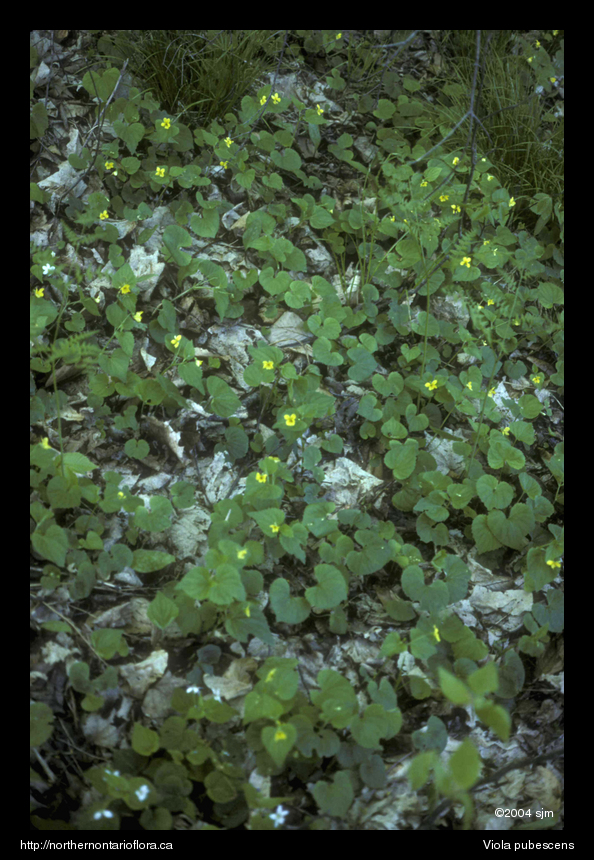
|
Northern Ontario Plant Database 
Plant DescriptionViola pubescens AitonEn: downy yellow violet, yellow forest violet
Violaceae (Violet Family) General: An erect, perennial herb (forb), the flowering stem to 4.5 dm tall, arising from a thick woody rhizome. Stems, leaves, and flower stalks (peduncles) covered in soft, velvety hairs, especially when young. Leaves: Alternate, simple, palmately-veined, long-stalked (petiolate); stem leaves 2–4, usually crowded near the top of the stem; plants sometimes also bearing 1–5 basal leaves. Leaf blades broadly heart-shaped (cordate) or kidney-shaped (reniform) to rounded (orbicular), 3–10 cm long and 1–3 cm wider than long; pale to dark green, hairy or becoming smooth (glabrate); leaf base cordate, the angle between the basal lobes (sinus) broad and open; apex blunt to pointed (acute); margins with rounded teeth (crenate); stipules lanceolate to ovate. There are two varieties of Viola pubescens in northern Ontario, the leaves of var. pubescens have 15–23 teeth on each side, while the leaves of var. scabriuscula have 8–15 teeth on each side. Flowers: Bisexual, axillary, flower stalks (peduncles) slender and downy. Sepals 5, narrowly lanceolate, with pointed tips (acute); petals 5, yellow, veined with purple, lateral petals bearded; stamens 5, the anthers surrounding the pistil touching but not fused to each other (anthers connivent); the single pistil with a superior ovary. Closed flowers that fertilize in bud (cleistogamous flowers) are borne in the axils of the leaves. Flowers bloom in late May to early June. Fruit: An ovoid capsule, usually hairy (pubescent), but occasionally smooth (glabrous), 5–12 mm long; seeds pale 2.5–2.9 mm long. Fruits mature in mid summer. Habitat and Range: Rich deciduous forests in eastern North America. In Ontario, the downy yellow violet extends north to Lake Timiskaming, around 47° 30' N (Scoggan 1978). Internet Images: The Viola pubescens webpage from the Gallery of Connecticut Wildflowers, a website of the Connecticut Botanical Society. Similar Species: The only other violet in northern Ontario with erect, leafy stems is the Canada violet, Viola canadensis, which has white flowers. The white petals of Viola canadensis bear a yellow spot at the base, while the back of the petals is often tinged with purple. When not in flower, the leaves of Viola canadensis may be identified by the deeper, narrow sinus between the basal lobes, whereas the leaves of the Viola pubescens have shallower, usually wider, sinuses. Compare Viola pubescens to the Viola canadensis webpage from the Gallery of Connecticut Wildflowers, a website of the Connecticut Botanical Society. Back to species list |
||||||||||||||||||||||












